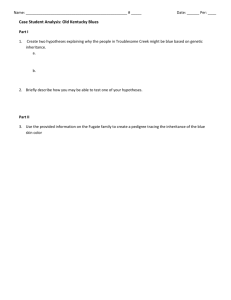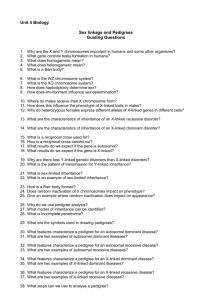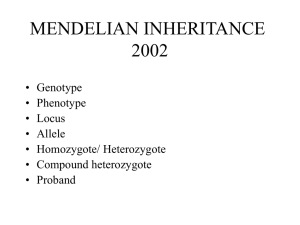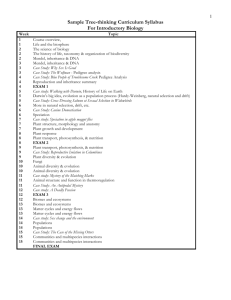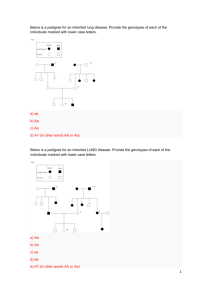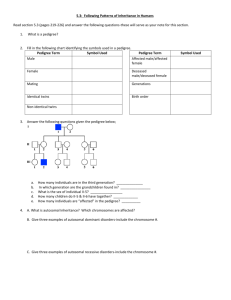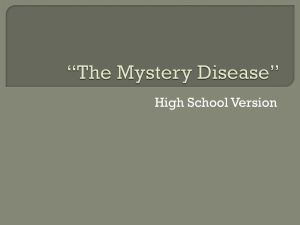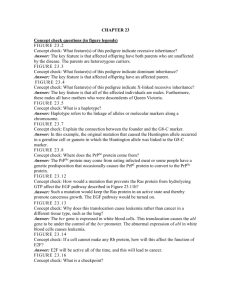X-linked Dominant Inheritance
advertisement
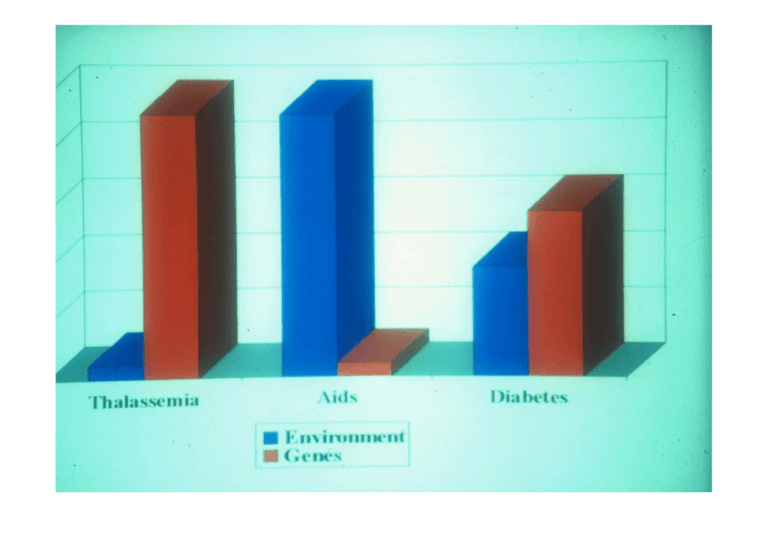
Classification of Genetic Diseases • • • • • Single gene mendelian medical disorders Chromosomal disorders Multifactorial inheritance Mitochondria inheritance Somatic mutation Single gene mendelian medical disorders OMIM http://www.ncbi.nlm.nih.gov/omim • • • • Autosomal dominant 3,802 reports Autosomal recessive 3,771 reports X-linked 1,848 reports Y-linked 266 reports • Over-all about 0.5-1% of live birth Genetic terminology • Genotype vs Phenotype • Allele vs Locus (Loci) A a B B A and B are loci. A or a is an allele of locus A. Locus A is heterozygous but locus B is homozygous. Achondroplasia The achondroplasia patient 15 years from now P What is the risk of his child? How to know the risk P What is the risk of his child? Your role • Understand mode of inheritance • Risk calculation • Counseling Mode of Inheritances - Classification of genetic diseases -Understand how genotypes are inherited. -Understand how genotypes lead to phenotypes. Risk calculation How to know classification of genetic diseases of the patient? (How to know inheritance of this patient?) The achondroplasia patient 15 years from now P What is the risk of his child? Punnett’s Square The achondroplasia patient 15 years from now P What is the risk of his child? 50% Please self describe characteristic of classical autosomal dominant pedigree The achondroplasia patient pedigree P Why is his parent normal? What is the risk of this child? The achondroplasia patient pedigree New Mutation P Why is his parent normal? Fitness vs Denovo Mutation Familial Hypercholesterolemia Severe Osteogenesis Imperfecta Who was most likely new mutation? Mosaicism Gonadal Mosaicism Recurrence risk of AD new mutation family is not zero. Genetic concept: Advanced parental age MATERNAL PATERNAL Chromosomal disorders (nondisjunction) Single gene defects: Autosomal dominant (point mutation) The achondroplasia patient 15 years from now P What is the risk of his child? Why is his parent normal? Retinoblastoma Example of Retinoblastoma pedigree I 1 How II2 is ill? 2 II How III1 is not ill? Risk of III4, IV2, IV3? 1 2 III P 1 IV 2 P 1 3 P 2 3 4 Example of Retinoblastoma pedigree I 1 How II2 is ill? AD inheritance 2 II 1 2 III P 1 IV 2 P 1 3 P 2 3 4 Example of Retinoblastoma pedigree I 1 How II2 is ill? AD inheritance How III1 is not ill? Non-penetrance 20% 2 II 1 2 III P 1 IV 2 P 1 3 P 2 3 4 Example of Retinoblastoma pedigree I 1 How II2 is ill? AD inheritance How III1 is not ill? Non-penetrance 20% Risk of III4 = 40% 2 II 1 2 III P 1 IV 2 P 1 3 P 2 3 4 Example of Retinoblastoma pedigree I 1 How II2 is ill? AD inheritance How III1 is not ill? Non-penetrance 20% Risk of III4 = 40% IV2 = 40% 2 II 1 2 III P 1 IV 2 P 1 3 P 2 3 4 Example of Retinoblastoma pedigree I 1 How II2 is ill? AD inheritance How III1 is not ill? Non-penetrance 20% Risk of III4 = 40% IV2 = 40% IV3 = 1/15 2 II 1 2 III P 1 IV 2 P 1 3 P 2 3 4 I ? II 1 II1 is 3 yr old. II2 is 1 yr old. Diagnosis? 2 I ? II 1 Two year later. II2 is 3 yr old. Diagnosis? 2 I ? II 1 2 1 2 I Three year later II2 is retinoblastoma. Why? II I ? II 1 2 1 2 I II1 was ill at 3 yrs but II2 is ill at 4 yrs. Why? Variation in expression (age of onset) II Neurofibromatosis I Example of Variation in Expression: Severity of Phenotype AD Inheritance- Exceptions • • • • New mutation Reduced penetrance Variable expressivity Germline mosaicism Examples of AD Disorders • Skeletal dysplasia – Achondroplasia – Osteogenesis imperfecta • Connective tissue disorders – Marfan syndrome – Ehlers Danlos syndrome • Craniosynostosis – Crouzon syndrome – Apert syndrome • Neurocutaneous syndrome – Neurofibromatosis – Tuberous sclerosis • Adult-onset genetic disorders – Familial hypercholesterolemia – Huntington disease – AD polycystic kidney disease Please do self study to understand these diseases’ phenotypes. No need to remember all detail at this point. Achondroplasia Osteogenesis imperfecta Marfan syndrome • • • tall stature Ectopia lentis Dilated arotic root Ehlers-Danlos syndrome Crouzon syndrome Apert syndrome Neurofibromatosis type I Tuberous sclerosis Angiofibroma Ashleaf Shagreen Summarized AD pedigree Example of Autosomal Recessive in Thailand Alpha Thalassemia Hydropfetalis Beta Thalassemia Autosomal recessive medical disorders in general are rare. 1:20,000 to 1:100,000 Nevertheless, some are more common in particular populations. Cystic fibrosis 1:2,000 to 1:4,000 in Caucasian. Phenylketonuria 1:10,000 in Caucasian. Sickle cell anemia 1:500 in African. Thalassemia (alpha & beta) Why? 1:100 in South-East Asia & Mediterranean Autosomal recessive medical disorders in general are rare. 1:20,000 to 1:100,000 Nevertheless, some are more common in particular populations. Why? -Selective advantage (of carrier) -Common ancestor -Mating within small population because of racial, geographic and ethnic differences. -Genetic drift Founder Effect A high frequency of a specific gene mutation in a population founded by a small ancestral group Original population Marked population decrease, migration, or isolation Generations later Autosomal Recessive Inheritance Absolute risk of birth defect between couple First degree relative Unrelated person First cousins P 30-50% 2-3% 4-5% Risk of birth defect from AR ¼ x pC x pC (pC = probability of being carrier) In this case II1 = ? P Risk of birth defect from AR ¼ x pC x pC (pC = probability of being carrier) In this case II2 = ? P The probability of being carrier in AR pedigree Consider II1 & II2 I1 & I2 & II3 III2 III3 (General Population) Risk of birth defect from AR ¼ x pC x pC (pC = probability of being carrier) In this case = ¼ x 2/3 x ¼ = 1/24 P Carrier frequency is approximately equal to Disease frequency1/2 x 2 For example if incidence of alpha thal is 1/100, the carrier frequency in this population is 1/1001/2 x 2 = 1/5 General frequency 1 = N2 + 2ND + D2 N is close to 1 and we know D2 = disease frequency. 2ND = Disease frequency1/2 x 2 Summary of AR pedigree Autosomal Recessive Inheritance • • • • Hemoglobinopathies, thalassemias Cystic fibrosis Most of inborn errors of metabolism Spinal muscular atrophy X-linked Recessive Inheritance Summarized X-linked pedigree Who are oligate carriers in this pedigree? 2/3 Carrier? Does X-linked Female show Phenotype? How? Carrier detection? X-linked Recessive Inheritance • • • • Hemophilia A Hemophilia B Duchenne muscular dystrophy Wiskott-Aldrich syndrome (X-linked immunodeficiency) • X-linked agammaglobulinemia • X-linked adrenoleukodystrophy X-linked adrenoleukodystrophy X-linked Dominant Inheritance X-linked Dominant Inheritance • Affected heterozygous females are seen. • Affected males with normal mates have no affected sons and no normal daughters. • Both male and female offspring of female carriers have a 50% risk of inheriting the phenotype. • The phenotype is about twice as common in females as in males. X-linked Dominant Inheritance • Affected heterozygous females are seen. • Affected males with normal mates have no affected sons and no normal daughters. • Both male and female offspring of female carriers have a 50% risk of inheriting the phenotype. • The phenotype is about twice as common in females as in males. Clues • Pedigree similar to AD, but no male-to-male transmission, with F:M = 2:1 X-linked dominant, lethal in male • Only female survives X-linked Dominant Inheritance • X-linked hypophosphatemic rickets • Incontinentia pigmenti • Rett syndrome Y-linked Inheritance • Only males affected • Male to male transmission • Examples: – SHOXY (Leri-weil, Langer mesomelic dysplasia) – Testes specific protein – Sex determining region Y – Zinc finger protein Y – Azoospermia factor 2 – Azoospermia factor 1 Summary Mendelian medical disorders • The family is suffering from a single gene disorder? • Mode of inheritance • New mutation & germline mosaicism • Penetrance • Variation in expression • Risk calculation • Carrier identification

